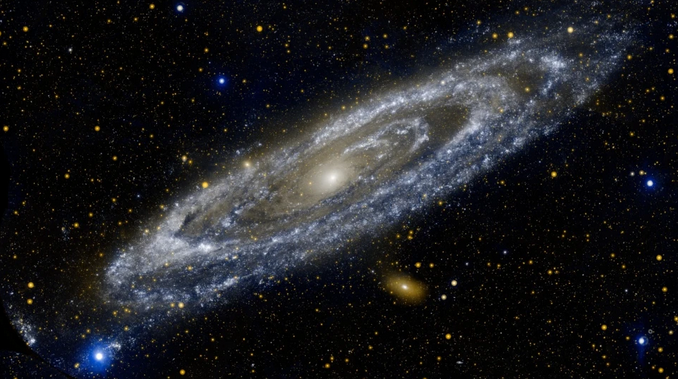
There is much discussion and speculation about Dark Matter on social media and elsewhere. The simple fact is that Dark Matter is a fudge factor to make up for the complete failure of General Relativity to account for the observed velocity distribution of galaxies.
According to Wikipedia:
Early radio astronomy observations, performed by Seth Shostak, later SETI Institute Senior Astronomer, showed a half-dozen galaxies spun too fast in their outer regions, pointing to the existence of dark matter as a means of creating the gravitational pull needed to keep the stars in their orbits.[36]
Vera Rubin, Kent Ford, and Ken Freeman‘s work in the 1960s and 1970s[37] provided further strong evidence, also using galaxy rotation curves.[38][39][40] Rubin and Ford worked with a new spectrograph to measure the velocity curve of edge-on spiral galaxies with greater accuracy.[40] This result was confirmed in 1978.[41] An influential paper presented Rubin and Ford’s results in 1980.[42] They showed most galaxies must contain about six times as much dark as visible mass;[43]: 13–14 thus, by around 1980 the apparent need for dark matter was widely recognized as a major unsolved problem in astronomy.[38]
At the same time, Rubin and Ford were exploring optical rotation curves, radio astronomers were making use of new radio telescopes to map the 21 cm line of atomic hydrogen in nearby galaxies. The radial distribution of interstellar atomic hydrogen (HI) often extends to much greater galactic distances than can be observed as collective starlight, expanding the sampled distances for rotation curves – and thus of the total mass distribution – to a new dynamical regime. Early mapping of Andromeda with the 300 foot telescope at Green Bank[44] and the 250 foot dish at Jodrell Bank, already showed the HI rotation curve did not trace the expected Keplerian decline. As more sensitive receivers became available, Roberts & Whitehurst (1975)[46] were able to trace the rotational velocity of Andromeda to 30 kpc, much beyond the optical measurements.
So it’s an open-and-shut case: galactic dynamics is not Newtonian!
The trouble is it is not relativistic either. The only way it can be explained is by introducing a completely new entity, dark mass, which has been pullled out of a hat for this sole purpose. This is not a scientific hypothesis – the existence of dark matter can never be disproved and its spatial distribution can always be adjusted, ad hoc, to fit the velocity distribution of any galaxy.
Dark matter must be the best non-science idea since phlogiston!


My two cents worth :
One of the great characteristics of scientific method is that it is a dynamic process, it has a go at describing the best explanation at the time with the knowledge at the time. That is how it profoundly differs from dogmatic processes like religions, or opinions. Without this acceptance, the community would be scared to “have a go” at the risk of being ridiculed. It expects to be improved, superseded.
I used to laugh at the Aristotelian four elements theory, right up until I read the amazingly clever Sophie’s World by Jostein Gaarder showing how closely it described the world with the knowledge then available. The elements:: earth, wind, water and fire.
Joseph Priestley discovered oxygen in 1774, Johann Joachim Becher’s terra pinguis and Georg Ernest Stahl’s phlogiston were attempts to explain fire and heat and life at least a 100 years earlier than oxygen was known about. It progressed on the concept of the element of fire.
With Priestley, and more careful experimentation, phlogiston is replaced by oxygen, which although not integral to combustible materials, is critical to burning, (and rusting and metabolism).
My second cent’s is about fudge factors and the mother of all fudge factors. It brings immediately to mind Einstein’s cosmological constant. His infamous fudge factor, adding in an arbitrary component to his theories of relativity to cater for his belief that the universe was not expanding despite that his equations suggested otherwise. We now know the universe is expanding, and in fact may be expanding too fast, whatever that means.
To my mind it is valid to add in a fudge factor, for unknown quantities. In budgeting we do it to cater for any error between our best guess and known results. We call it a contingency. So Einstein had his contingency. Of course if the fudge factor proves to not be a reality, its value just defaults to zero.
In a NYT article from 1998, the idea of “funny energy” is introduced and by 2010 in a New Scientist article has it down as “dark energy” while reminding us that energy and matter are the same thing. More or less, give or take a bit, here and there. Since we know nothing about dark matter/energy, maybe they are not the same thing over there.
Or maybe Einstein’s equations need tweaking as he in turn tweaked Newton’s.
Allan, how about earth, wind, water and plasma. Most of the material in the known Universe is in the plasma state. Fire is just the closest thing to plasma in human experience.
I’d definitely add plasma in.
Astronomy, like astrology, and many other human endeavours, scientific or not, should be a self-funded hobby without the least subsidisation or tax-deductability.
Jacob – substitute “Cosmology” for “Astronomy” and I might agree with you. According to Wikipedia on “Amateur Astronomy”. Astronomy is one of the few remaining areas of science where amateurs make a useul contribution. NASA’s James Webb telescope is finding amazing new stuff faster than the Cosmologists can account for it.
Ah, where would we be without the precursors? Astrology, alchemy, phrenology, eugenics, Lamarckism, Ptolemy, Bill Haley.
There was a time of course when all natural history was the realm of the rich and idle, their hobbies.
I don’t think we can do it nowadays because of “big science.” Atomic particle colliders, DNA sequencing, large language models, holidays on the moon, Google searches. In fact all things googol.
Astronomers do it, e.g. Google Comet Lovejoy named after an Australian amateur!